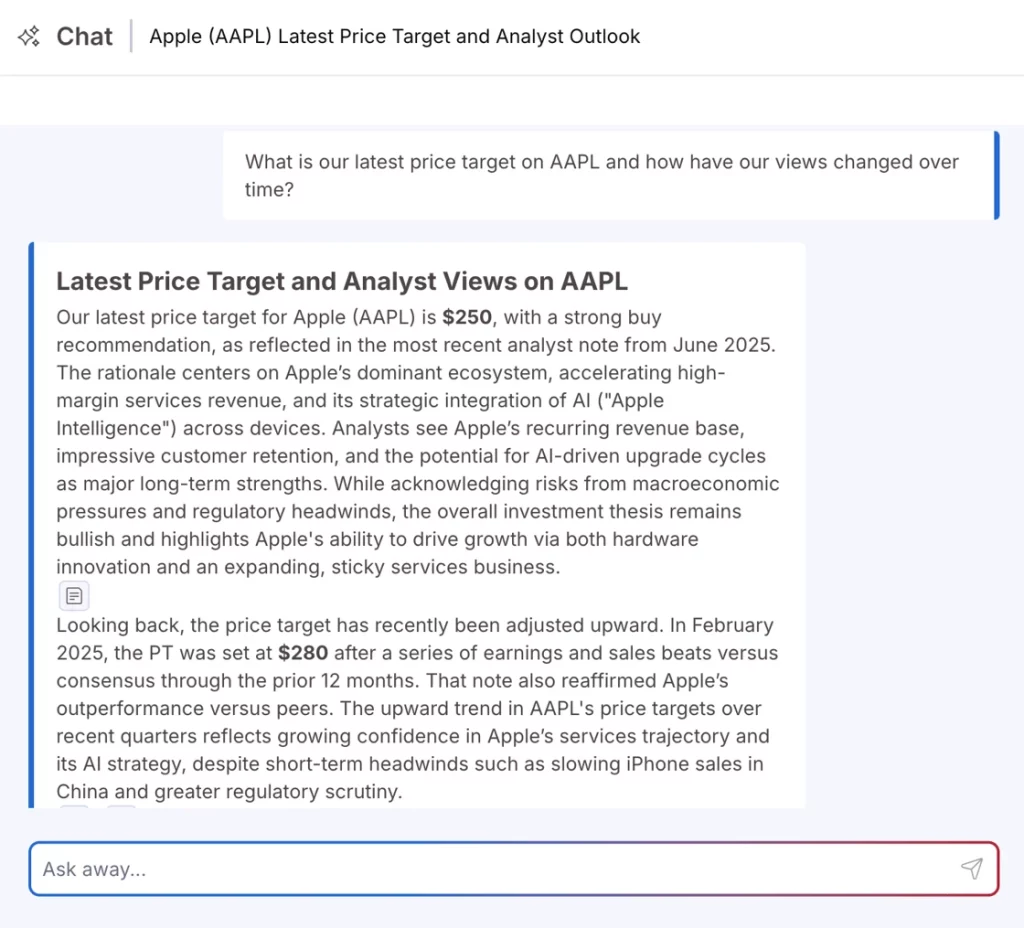
Fund Workflows: How to Optimize for Operational Alpha
Discover how funds are earning operational alpha by solving for front-office workflow inefficiencies.
While pursuing alpha is the main prerogative of investment research teams, many asset managers and hedge funds are wringing waste out of their research process by looking at how teams drive ideas through the pipeline and into the portfolio.
In this article, we’ll cover how firms are tackling inefficiency by optimizing their mutual fund or hedge fund workflows, the benefits of which are termed “operational alpha.”
What Is Operational Alpha? A Definition
Operational alpha is the bottom-line savings achieved by improving fund efficiency, processes, and workflows.
Operational alpha is value generated by the firm outside of a fund’s portfolio. Operational alpha is becoming an important concept as funds grow in size and complexity.
Why Fund Workflows Matter
A smooth, strong fund workflow can improve operational performance & efficiency, reduce the need for compliance to interfere, help teams learn from success & failure, and ultimately, get the best ideas into the portfolio sooner.
Robust workflows can:
Improve Performance: Front-office workflows can be overlooked by some funds. But with process efficiency and automation, teams can nearly eliminate the drag created by jumping around between tools and platforms and focus on what they are rewarded for: driving alpha.
Simplify Compliance: Whether the need for heightened cybersecurity or the looming threat of an SEC audit, many funds are finding that compliance safeguards and workflows can reduce disruptions and streamline reporting.
Build Confidence: How quickly are ideas moving into the portfolio? Are you learning from successes and failures? Good workflows bring confidence to funds by helping them do more of what’s working.
As the Hedge Fund Journal puts it:
The brilliance of the market strategy and the execution skill of the analyst won’t make any difference if the quality of the data inputs and the execution tools aren’t up to scratch. Indeed, a suitable analogy would be employing a master carpenter to build one’s home whilst only allowing him access to poor quality tools.
Execution is everything. The right tools make a meaningful difference.
Related Content: The Research Management Winning Playbook
What Is a Good Fund Research Workflow? The 3 Cs
The best workflow will be the one that works best for your team. At Verity, we categorize research workflows using the following framework.
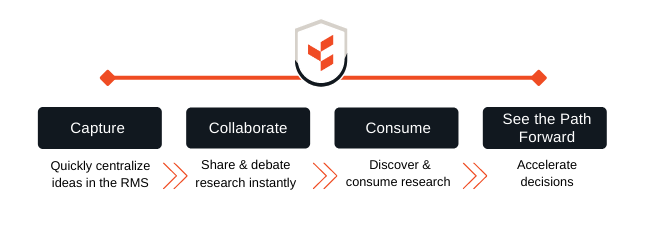
When we pay attention to front-office teams and how they participate in the process of pushing ideas through this pipeline, we can uncover where issues may be and how to best resolve them.
From idea generation to compliance and monitoring, here are some examples of typical fund workflows and customizations prized by customers of Verity’s research management system.
Analyst Research Workflows
If you want to accelerate and/or scale a workflow, you need to reduce the processing power required to create and digest the information in the first place.
If, as an analyst, you need to start from scratch every time you are putting together your analysis, then you also have to make adjacent decisions about format, priority, and structure of information. It slows you down. If, as a portfolio manager, you are receiving recommendations, briefings, and more in a variety of formats, it stalls your ability to see the signal from the noise.
The best way to combat this workflow inefficiency is to standardize the information that’s getting shared, and create a sense of cohesion with the investment process.
VerityRMS customers take advantage of note templates. They often require analysts to provide essential information for investments (such as target prices, thesis, upcoming catalysts, ESG indicators, etc.) or calls with expert networks (such as the name of the provider, compliance approval, or point value of call). Analysts avoid starting from scratch and portfolio managers can scan notes without digging for context.
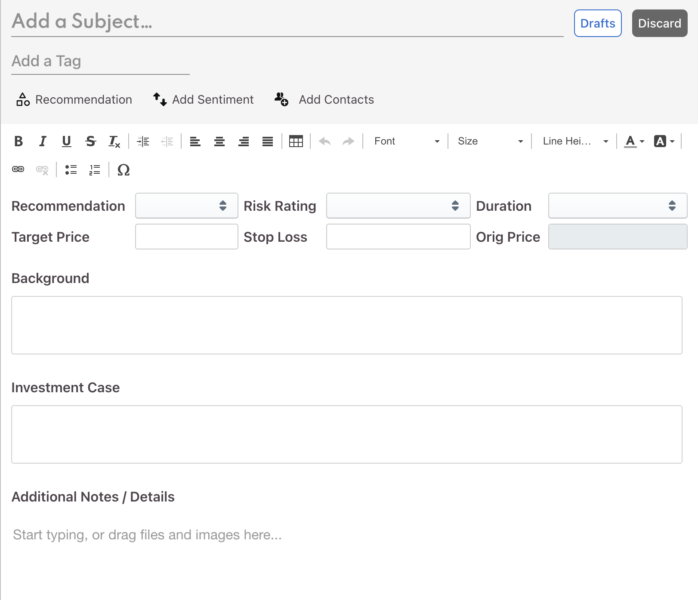
With customizable note templates, analysts don’t have to reinvent the wheel. PMs can review notes with a high signal-to-noise ratio.
Modeling & Data Workflows
What triggers are analysts monitoring? How many different places do they have to go to get them?
One way to optimize a workflow is to consolidate the inputs, put the important information in one place. Not only good for saving time, this adds a layer of context that can help analysts make connections quicker than they have before. You may want to pull in ESG data via Sustainalytics, insider activity data via VerityData, or another 3rd party data provider.
Is your data going everywhere it needs to go? Is data across analysts models easily consumable in one place?
Many hedge funds use the VerityRMS Excel integration to ensure all of the above.
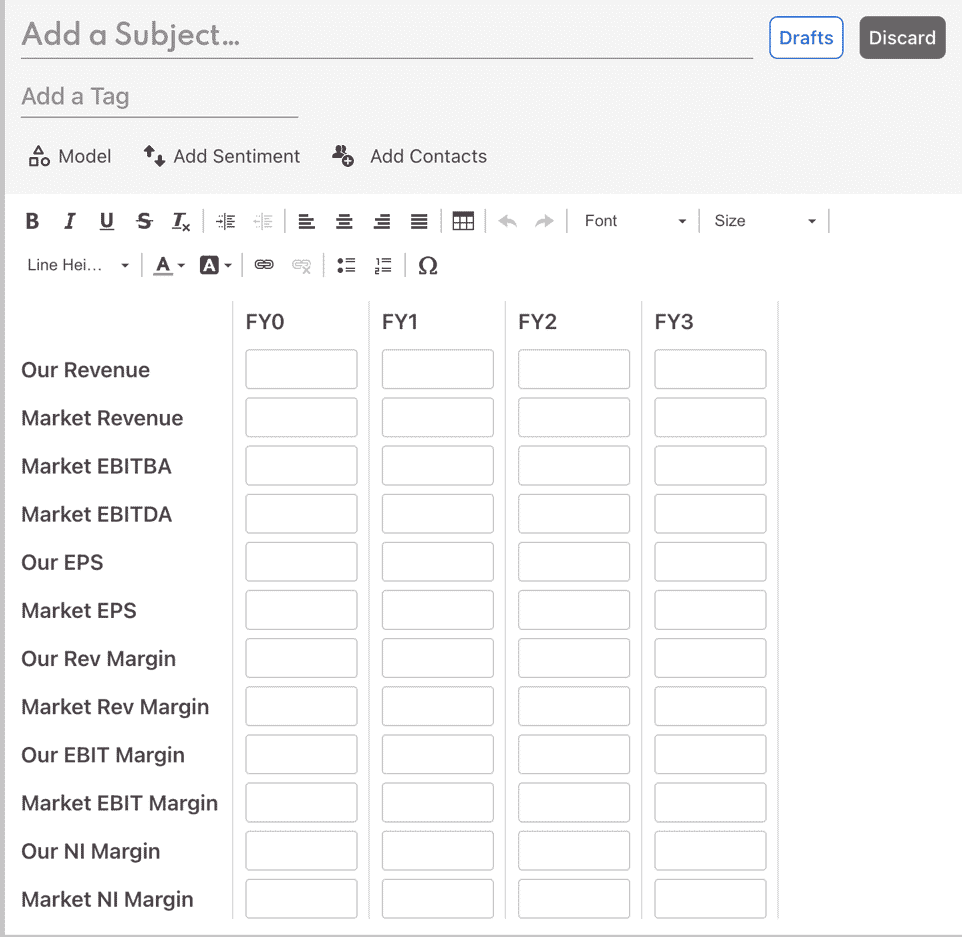
The RMS add-in sits on-top your team’s proprietary model structure, ingesting the fields you care about. Estimates, price targets and more can be fed to the RMS — without leaving Excel — creating custom views for portfolio managers.
Compliance Workflows
Compliance tasks, though necessary, typically disrupt an analyst’s workday. At the same time, compliance officers must track down the information they need, which may be spotty in the first place.
Some hedge funds are proactive about enforcing compliance protocols. For example, they set a limit on what can be downloaded from the RMS. Others simply wish to monitor if many notes are downloaded at once or view the iteration history of a note.
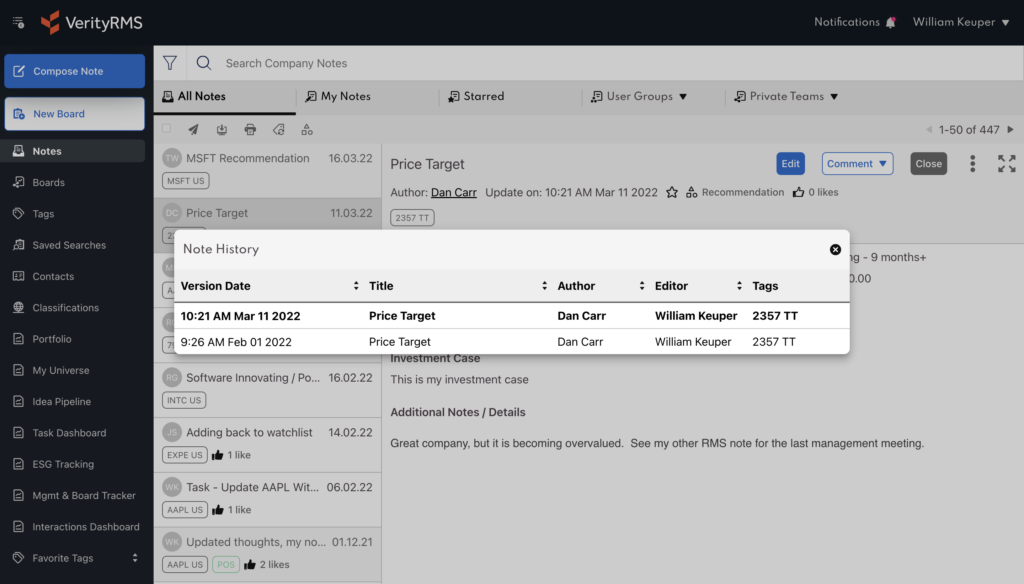
Example VerityRMS note history shows all versions of a recommendation.
Tracking expert network calls is another compliance-related workflow optimization. If you use a structured note template to capture details of the call (broker, rating, compliance questionnaire, etc.), then the RMS can pull the note and its metadata (date, author, tag/ticker, company) into a dashboard, as shown below, that can confirm compliance questions were answered prior to the expert call.

By tracking expert network calls, fund not only have compliance benefits, but can also determine which brokers must be paid.
Importantly, compliance officers using a modern RMS have full access and audit insights into the entire investment story. All content, data, and notes that went into an investment decision are automatically organized and only a click or two away — without bothering the investment team.
Portfolio Management Workflows
Another common use case for a fund workflow is to use the RMS as a portfolio management tool.
Recommendations from analysts can populate a dashboard tracking active and passed ideas, price targets, theses, and more.
In VerityRMS, these fields are entirely customizable, and can be integrated with your holdings and/or PMS system. You can get market data from S&P Global, or any other third-party, for actionable, performant, and market-driven workflows within the RMS. Many investors create custom landing pages so the RMS does the work for them.
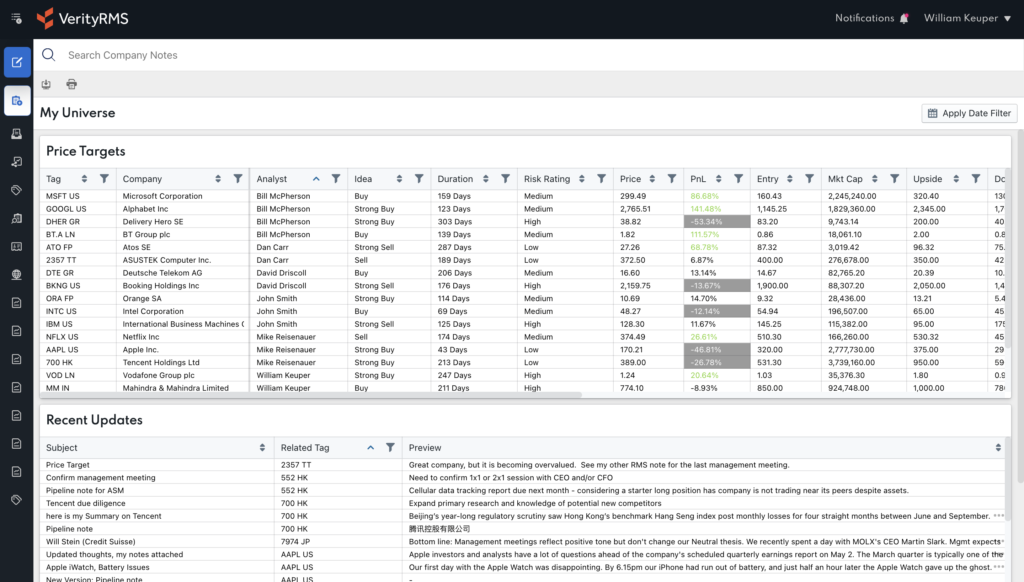
One of an infinite number of possible dashboards. PMs can also integrate an internal or 3rd party portfolio tool.
ESG & Impact Investing Workflows
More and more firms are integrating ESG processes into the RMS. Impact investing and engagement tracking, for example, are essential to many asset manager mandates. But creating insights and reporting can be difficult.
Many funds use VerityRMS to streamline ESG issue tracking, engagement, and impact processes. The result has positive impacts on portfolio management, investor queries, and regulatory requirements.
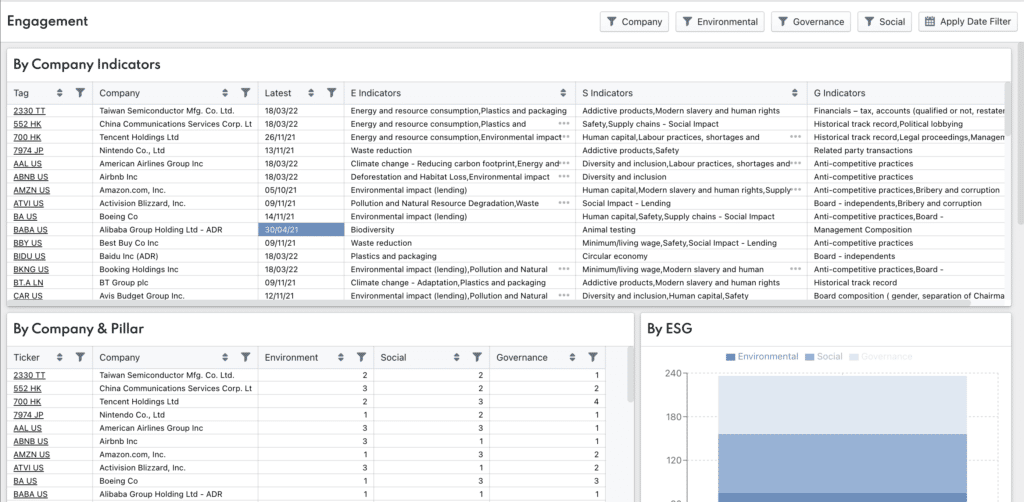
How integrated is ESG into your research process? Many funds track things like engagement (above) to optimize efficiency.
AI-Enhanced Research Workflows
One of the biggest workflow breakthroughs in recent years has been the integration of artificial intelligence into the research process. Rather than replacing analyst judgment, AI is eliminating the busywork that slows teams down. It’s letting analysts focus on analysis and insights — not data entry.
Many VerityRMS customers are now leveraging AI to streamline their workflows:
- Auto-tagging eliminates manual categorization by learning from your tagging patterns.
- Auto-extraction pulls key information from emails to populate template fields automatically.
- Summaries help portfolio managers quickly digest lengthy research notes.
- Chat allows teams to query their proprietary research for novel insights.
- Report building that lets users create quick insightful reports.
Bottom Line
Hopefully, these examples provided transparency into how hedge funds are improving their front-office workflows and driving operational alpha.
As mentioned, the best workflow is the one that works for your team. At Verity, we work with funds all over the world, making sure to keep what sets you apart stays intact. At the same time, we can introduce workflow efficiencies that are nearly universal across firms.
Could VerityRMS Bring Value to Your Fund?
Find, share, and act on insights faster — without losing control of your process. With VerityRMS, you can connect investment teams to the research, data, and tools they need while cutting out the busywork that slows them down.




Outperformance Starts Here
See how Verity accelerates winning investment decisions for the world's leading asset managers.
Request a Demo